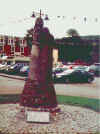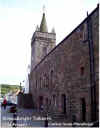The ancient
Royal Burgh of Kirkcudbright is steeped in history and
features in several incidents of note. It is from
Kirkcudbright that William Wallace took ship to France
after the battle of Falkirk in 1298.

Two years later the English fleet supporting the invasion
of Edward I landed troops here. A stronghold of the
Douglases during their Lordship they were broken by James
II in 1455. In the same year the town was created a Royal
Burgh. In 1507 the town was virtually destroyed when the
Earl of Derby and a fleet of Manx ships attacked. But a
Galloway fleet was raised under Cutlar MacCulloch and the
Isle of Man was terrorised in turn. The Galloway coast was
a possible landing place for the Spanish Armada – it was
recommended to Philip of Spain by Lord Maxwell, a leading
Roman Catholic in southern Scotland. Maxwell went so far
as to repair fortifications and muster his tenants
in readiness for the landing but his action was suppressed
before the Armada arrived off of Cornwall. In 1690 the
fleet of King William III lay at anchor in
Kirkcudbright for several days, while the port was one
which was liable to landings in the later Jacobite
risings. It was Kirkcudbright Bay that
John Paul Jones sailed into during the War of
Independence with America intent on taking the Earl of
Selkirk prisoner; all he got was the Earl`s silverware
which, surprisingly, was returned six years later in 1784
as a matter of honour.
The
Tolbooth in Kirkcudbright has held some notable prisoners,
including John Paul Jones for a while. But it was
probably most remembered as the holding place of many
Covenanters in the late seventeenth century. Galloway and
Ayrshire were the homeland of the strict Presbyterians
later to be called Cameronians and Society people, and the
district the scene of many conventicles with preachers

such as Alexander Peden. Many of the martyrs of the
Covenant were ministers in the area. It was at Kirkconnel
Moor, north of the town, that five men at prayer were
caught and executed by Sir Robert Grierson of Lagg on 21
February 1685. The Old St Cuthbert`s church yard contains
the graves of Covenanters, William Hunter and Robert
Smith, who were victims of a skirmish at Auchencloy. They
had been involved in a mass break out from the Tolbooth on
16 December 1684 but John Graham of Claverhouse (later
Viscount Dundee) found the party and five men were killed
in the skirmish. Another grave is that of a young man of
about eighteen, John Hallam, who was wounded when he ran
away from some soldiers and later hanged for refusing to
take the infamous Abjuration Oath.

Around the
edge of the table gravestone is the inscription
WILLIAM HOUNTURE
ROBERT SMITH 1684
The main inscription reads
THIS MONUMENT SHALL SHEW POSTERITY
TWO HEADLES MARTYRES UNDER IT DOTH LIE
BY BLOODY GRHAME WERE TAKEN AND SURPRISED
BROUGHT TO THIS TOUN AND AFTERWARDS WERE SAIZ’D
BY UNJUST LAW WERE SENTENCED TO DIE
THEM FIRST THEY HANGED THEN HEADED CRUELY
CAPTANS DOUGLAS BRUCE GRAHAME OF CLEVERHOUS
WERE THESE THAT CAUSED THEM TO BE HANDLED THUS
AND WHEN THEY WERE UNTO THE GIBBET COME
TO STOPE THEIR SPEECH THEY DID BEAT UP THE DRUM
AND ALL BECAUS THAT THEY WOULD NOT COMPLY
WITH INDULGENCE AND BLOODIE PRELACIE
IN FACE OF CRUEL BRUCE DOUGLAS AND GRAHAME
THEY DID MANTAINE THAT CHRIST WAS LORD SUPREAM
AND BOLDLY OUNED BOTH THE COVENANTS
AT KIRKCUDBRIGHT THUS ENDED THESE TWO SANTS.
Nearby to
the grave of John Hallam is that of a true `character` of
Galloway, that of William Marshall the ” Caird of
Barullion “, King of the Gypsies of the Western Lowlands.
Reputed to have been 120 years old when he died, he is
said to have fathered at least four children after he was
one hundred. Married some seventeen times he led a band of
gypsies who lived in the wild moors around Barhullion.
Said to have been in the army seven times he deserted as
many; also he ran away from the navy three times.
Billy Marshall as he preferred to be known was much
involved in the `Leveller` protests in 1725 when the
common people rose against the practice of fencing and
placing dykes round grazing land, throwing many out of
work. The stone is adorned with two ram`s horns and two
tablespoons which are carved on the other side. The
inscription reads :
The Remains of
William Marshall
Tinker,who died
28th Novr. 1792
at the advanced age of
120 Years.
